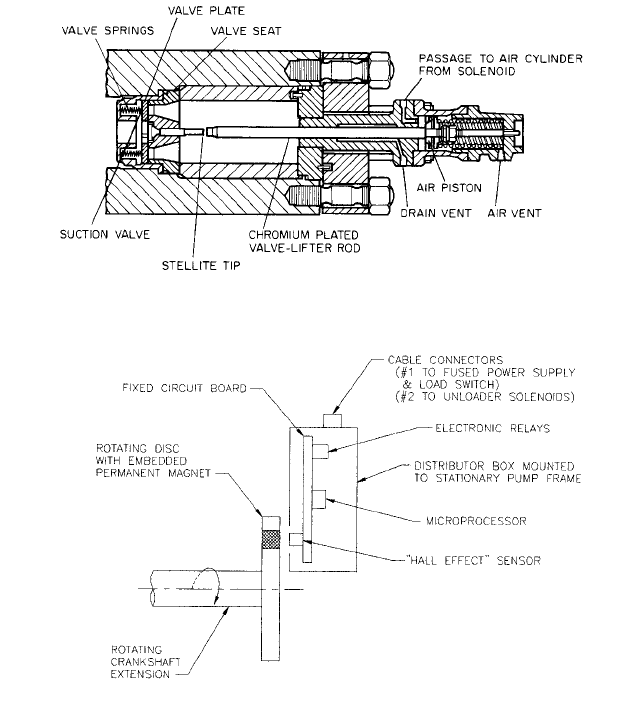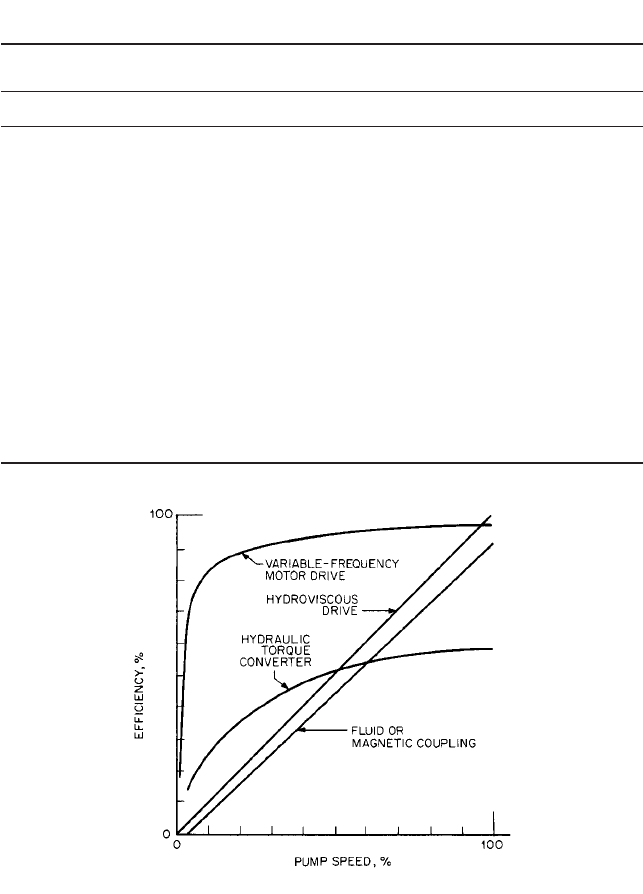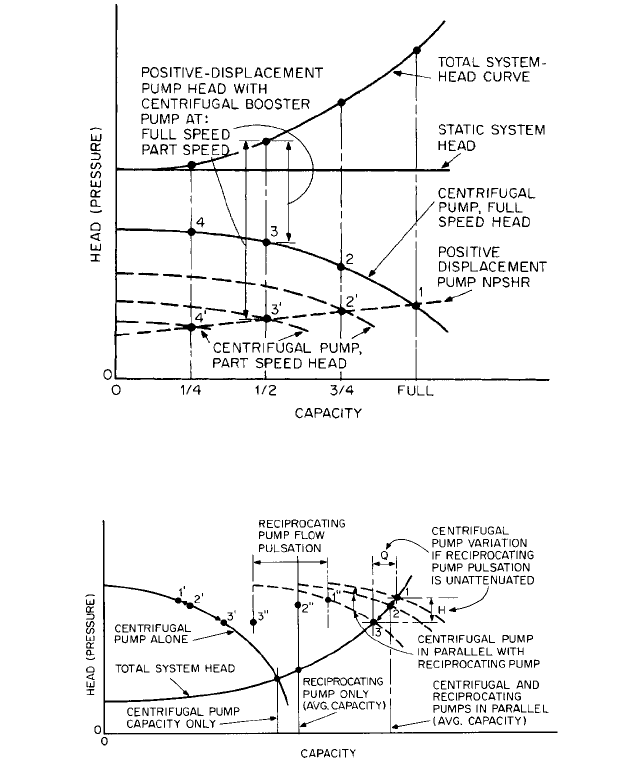Pump Handbook by Igor J. Karassik, Joseph P. Messina, Paul Cooper, Charles C. Heald - 3rd edition
Подождите немного. Документ загружается.

3.4 DISPLACEMENT PUMP PERFORMANCE, INSTRUMENTATION, AND DIAGNOSTICS 3.73
probes can be used at the bearings to measure movement of the shaft relative to the bear-
ing centerline.
Diagnosis of Shaft Failures Pump and driver shafting can experience high stresses
during start-up and normal operation because of the uneven torque loading of the posi-
tive displacement pumping action. Shaft failures are strongly influenced by the torsional
resonances of the system, which are the angular natural frequencies of the system.
Torsional vibrations can be measured using velocity-type torsional transducers that
mount on a stub shaft. Alternatively, they may be gauged by measuring the gear tooth
passing frequency with a magnetic transducer or proximity probe and using frequency-to-
voltage converters to give the change in tooth passing frequency (the torsional vibrational
velocity). Spectral analysis of these signals defines the torsional amplitudes and natural
frequencies. The stresses can be calculated by using the mode shape of the specific reso-
nant natural frequency and combining all the torsional loads. Torsional natural frequen-
cies, mode shapes, and stresses can be calculated by using either the Holzer technique or
digital computer programs.
12
Torsional problems can usually be solved by changing the coupling stiffness between
the driver and pump or by using a flywheel in an effective location. The addition of a fly-
wheel will tend to smooth the torque oscillations. Pumps with a greater number of cylin-
ders and equal cylinder phasing usually operate more smoothly with lower shaft stresses.
REFERENCES _______________________________________________________
1. Von Nimitz, W. W. “Reliability and Performance Assurance in the Design of Recipro-
cating Compressor and Pump Installation.” 1974 Purdue Compressor Technology
Conference.
2. Sparks, C. R., and Wachel, J. C. “Pulsation in Centrifugal Pump and Piping Systems.”
Hydrocarbon Processing, July 1977, p. 183.
3. Hayward,A. T. J. “How to Estimate the Bulk Modulus of Hydraulic Fluids.” Hydraulic
Pneumatic Power, Jan. 1970, p. 28.
4. Wright, W. A. “Prediction of Bulk Moduli and Pressure-Volume-Temperature Data for
Petroleum Oils.” ASLE Transactions 10:349, 1967.
5. API Technical Data Book, Petroleum Refining, 2nd ed., Washington, D.C., 1972.
6. Klaus, E. E., and O’Brien, J. A. “Precise Measurement and Prediction of Bulk-Modulus
Values for Fluids and Lubricants.” Journal of Basic Engineering, September 1964,
p. 469.
7. Noonan, J. W. “Ultrasonic Determination of the Bulk Modulus of Hydraulic Fluids.”
Materials Research and Standards, December 1965, p. 615.
8. Hicks, E. J., and Grant,T. R.“Acoustic Filter Controls Reciprocating Pump Pulsations.”
Oil and Gas Journal, January 15, 1979, p. 67.
9. American National Standard for Reciprocating Power Pumps for Nomenclature, Def-
initions, Application and Operation, ANSI/HI 6.1-6.5-2000, Hydraulic Institute, Par-
sippany, NJ www.pumps.org.
10. Machine Design, Fluid Power Reference Issue, vol. 52, no. 21, Penton Publications,
Cleveland, 1980.
11. Wachel, J. C., and Bates, C. L. “Techniques for Controlling Piping Vibration and Fail-
ures.” ASME paper 76-Pet-18, 1976.
12. Szenasi, F. R., and Blodgett, L. E. “Isolation of Torsional Vibrations in Rotating
Machinery.” Proceedings of the National Conference on Power Transmission, vol. II,
Illinois Institute of Technology, 1975.
3.74 CHAPTER THREE
FURTHER READING __________________________________________________
Positive Displacement Pumps: Reciprocating, API Standard 674, 2nd ed., 1995, American
Petroleum Institute, Washington, D.C., www.api.org.
Positive Displacement Pumps: Controlled Volume, API Standard 675, 2nd ed., 1994,
American Petroleum Institute, Washington, D.C., www.api.org.

WILL SMITH
3.75
SECTION 3.5
DISPLACEMENT PUMP
FLOW CONTROL
FLOW CONTROL IN INDIVIDUAL PUMPS _________________________________
An inherent characteristic of positive displacement pumping of relatively incompressible
liquids is that flow rate is proportional to displacement rate and independent of pressure
levels. The capacity of a centrifugal pump operating at constant speed varies from a max-
imum flow at no developed pressure to zero flow at a definite limiting pressure known as
shutoff head. The average capacity of positive displacement pumps at constant speed is,
within design limits of pressure, practically constant, even though flow rate pulsations do
occur as individual displacements are forced into the discharge pipe.
Flow control of positive displacement pumps is accomplished by
• Changing the displacement rate
• Changing the displacement volume
• Changing the proportion of the displacement delivered into the piping system
Throttle Control in Direct-Acting Steam Pumps Direct-acting pumps are controlled
by speed change, which is effected by throttling the flow of steam (or other motive gas) to
the drive cylinder. The magnitude of excess force on the drive piston over that required
for the driven, or pumping, piston to force pumpage into the piping system dictates the
stroke rate and therefore the capacity of the pump.A sensor that detects the desired result
of pumping (pressure, level, flow rate, and so on) may be used to modulate the steam throt-
tle valve.
Speed Control in Power-Driven Pumps Speed modulation is the most common means
of flow control for power-driven pumps. The most rudimentary speed control is intermit-
tent (start-stop) operation. The average capacity over relatively long time periods depends
upon the percentage of time the pump operates at 100% versus the percentage of time it
3.76 CHAPTER THREE
operates at zero flow. Of course, consideration must be given to the frequency of starts
because electric motors may overheat if there is insufficient time for cooling after the
inrush of starting current.
When continuous modulation of flow is desired, means of varying the driver speed or
the ratio of speed reduction between the driver and pump are employed.
DRIVER SPEED CONTROL
1. Multispeed constant-torque motors offer limited steps in speeds.
2. Variable-frequency motor controls permit a wide range of fully modulated speeds but,
at present, are limited in maximum horsepower (Subsection 6.2.2).
3. Direct current and wound rotor alternating current motors permit modulation of
speeds within definite limits of torque capability (Subsection 6.2.2).
4. Gasoline and diesel engines provides speed variation capabilities within the limits
where driver torque is adequate to satisfy the constant-torque requirements of the
pump (Subsection 6.1.3).
5. Steam or gas turbines can operate over a limited speed range within their particular
output torque limits (Subsections 6.1.2 and 6.1.5).
SPEED CHANGER CONTROL Because most positive displacement pumps operate at signifi-
cantly lower speed than most drivers, a speed reduction unit is coupled between driver
and pump. Capacity control by varying the ratio of the speed reduction is quite convenient.
A number of methods are used.
1. Variable-ratio belt drives change the speed by changing the pitch diameter of driver
and driven sheaves in response to capacity requirements (Subsection 6.2.5).
2. Hydraulic torque converters (hydrodynamic drives) vary the speed by regulating the
amount of active drive fluid in the coupling. Because these converters relate torque to
speed, they are sensitive to the driven torque requirement change that may derive
from system pressure changes (Subsection 6.2.3).
3. Hydroviscous drives vary the slip between input and output shafts by adjusting the
distance between elements in a viscous fluid environment (Subsection 6.2.3).
4. Eddy-current couplings also vary the slip between driver and driven elements but do
so by varying the strength of a magnetic field (Subsection 6.2.1).
Variable Displacement Flow Control Rather than by speed control (changes in the
number of displacements in a given period of time), flow may be varied by changing the
volume displaced per stroke.
Variable strokes are generally limited to small metering or “controlled volume” pumps.
Although large-capacity variable-stroke pumps have been built, the complexity of the
mechanism involved and the development of other effective and economical means of flow
control have precluded their use (Subsection 9.16).
Changing Delivery to the System Another means of capacity control is not to vary the
pump capacity but to alter the amount of pumpage delivered to the system. There are two
popular means of doing this.
SUCTION VALVE UNLOADING Suction valve unloaders cause the displacement to be ineffec-
tive during the strokes for which the unloaders are activated. They command either full
or zero delivery while the pump is kept running. Thus, current inrush problems from fre-
quent motor starts are avoided. Because discharge pressure is not developed when suc-
tion valves are unloaded, energy consumption is held to a minimum.
A pump valve is unloaded by mechanically preventing the valve plate from returning
to its seat. If the suction valve is held away from its seat, liquid will ebb and flow through
the valve from suction header to pump cylinder and from cylinder to header during the
stroking of the plunger or piston.

FIGURE 2 “Hall effect” microprocessor distributor system.
3.5 DISPLACEMENT PUMP FLOW CONTROL
3.77
FIGURE 1 Synchronized unloading keeps the valve open through the use of a suction valve unloader.
The unloader mechanism does not move the valve.The valve is lifted off its seat by the
pressure differential created by normal pump operation. In synchronized unloading, the
suction valve unloader (Figure 1) is retracted only when it is certain that the incoming
flow will keep the valve open.
The unloader never resists pressure in the cylinder; it merely holds the valve plate
against valve springs that had already been compressed and moves away from the valve
while the springs are still compressed. This permits the valve to close when the plunger
begins its discharge stroke.
For smooth transition between full flow and zero flow, the unloading and loading are
accomplished in an immediate and identical sequence of the pumping order of the
plungers. It is the function of the synchronized suction valve unloader distributor (Figure
2) to control unloading events in that proper and immediate sequence. Similarity can be
drawn to the gasoline engine distributor in its function of assuring the proper and imme-
diate sequence of firing of the spark plugs.
The distributor is driven directly by the crankshaft so its position is positively indexed
to the stroking of the plungers. It provides an electrical signal to a solenoid valve, which
3.78 CHAPTER THREE
admits motive fluid pressure to the unloader chamber when the suction valve to the par-
ticular cylinder has been opened. Then, in sequence, each of the remaining suction valves
is retained so, in the first revolution of the pump after a control signals the distributor to
initiate unloading, all suction valves are unloaded and the pump capacity is reduced to
zero. When the control again signals for capacity, each suction valve is released, in
sequence, during a single revolution of the crank.
While unloaded, the discharge valves do not function; they remain closed and serve as
check valves against the pressurized discharge system. The suction valves remain open.
Liquid enters from and is dispelled back into the suction manifold through the open suc-
tion valves. Therefore, no work is applied to the liquid, not even that required to open the
suction and discharge valves. When the control calls for loading, the load is applied in
steps equal to the number of plungers. Thus the pumping horsepower, as well as the liq-
uid inertia in the pumping system, is changed in a number of steps equal to the number
of plungers over the time span of one crank revolution.
The unloader consists of a spring-loaded pneumatic cylinder attached to the suction
valve cover. The spring advances holding fingers that keep the valve away from its seat.
Pneumatic pressure, applied through a solenoid valve in response to the distributor signal,
creates a force on a piston that opposes the spring force and allows the suction valve to
load (close). The system is normally arranged to fail in the unloaded position on either
electrical or pneumatic pressure failure.
Distributor systems have evolved from a) direct mechanical linkages between recipro-
cating parts and the suction valves, to b) electromechanical interfacing, to c) electronic
proximitor systems, to d) a “Hall effect” sensor signaling a microprocessor. The objective of
each of these systems is to cause suction valve unloader solenoids to activate or de-activate
in the appropriate sequence and at the appropriate position of the plunger during the suc-
tion stroke.
BYPASS CONTROL
Ultimate delivery of pumpage to the system may be controlled by a
discharge-to-suction bypass valve. Pump operation is continuous, with the possibility of
modulating the flow to the system by regulating the portion “bypassed” to suction. A seri-
ous disadvantage is the full power utilization and full-load wear and tear even when at
zero system capacity.
Evaluation of Flow Control Options Proper selection of the means of capacity control
requires consideration of system control requirements and then evaluation of the options
available to satisfy those requirements.
Precision, responsiveness, and degree of modulation required may limit options. First
cost, maintenance requirements, and the effect on pump operating cost should then be
weighed for viable options.To evaluate the effect of operating costs, it is necessary to deter-
mine (or reasonably assume) the expected pattern of operation throughout the capacity
range. For example, if practically all operation except infrequent start-ups is to be at full
pump capacity, little penalty should be assigned to the full power usage of a bypass valve
or to the part-load losses inherent with hydroviscous or eddy-current drives.
If smooth modulation of flow is not essential, start-stop or suction valve unloading may
be the preference. If smooth modulation and considerable operation at part capacity are
necessary, variable-frequency motors or variable-pitch V-belt drives may be indicated.
Table 1 and Figure 3 provide some general guidelines. Each application should be eval-
uated on the merits of requirements and options.
FLOW CONTROL IN COMBINED DISPLACEMENT AND CENTRIFUGAL PUMPS
Systems that involve both centrifugal and reciprocating positive displacement pumps
deserve some special consideration. Centrifugal pumps are often used as suction boosters
to overcome acceleration head requirements peculiar to reciprocating pumps but are
rarely used to supplement flow. Some unique characteristics of each type of pump that
affect the other type must be considered in the design, operation, and control or the inter-
related system.

3.5 DISPLACEMENT PUMP FLOW CONTROL 3.79
TABLE 1 Comparison of several capacity control schemes for positive displacement
pumps
Control Degree of First Operating
Method Modulation Cost Cost Comments
Directing-acting pumps
Steam Full: zero Low Low Steam pressure required to
throttle to 100% balance liquid piston force
and overcome breakaway
friction. Steam volume
throttled to produce
desired capacity.
Power pumps
Start-stop Zero or 100% Low Low Limited in frequency of
starts because of tempera-
ture rise from inrush.
Multispeed Steps Medium Low Cost of motor controller
motors dependent switch gear motors must
on motor be assessed.
winding
Variable Full: zero to High Low Limited by current-handling
frequency 100% capacity of solid-state
controller.
Direct Full: zero High Medium Drive is torque-speed
current to 100% sensitive, pump is torque-
pressure sensitive at all
speeds. Check drive for
required torque at
minimum and maximum
speeds.
Wound Full: zero High Low Drive is torque-speed
rotor to 100% sensitive. Pump is torque-
motors pressure sensitive at all
speeds. Check drive for
required torque at
minimum and maximum
speeds.
Combustion Variable for High Low Torsional analysis required
engines limited to avoid high torsional
range stresses.
Steam or Variable for Medium Medium Drive is torque-speed
gas limited sensitive. Pump is torque-
turbines range pressure sensitive at all
speeds. Check drive for
required torque at
minimum and maximum
speeds.
Hydraulic Full: zero High High Low full speed efficiency.
torque to 100%
converter

3.80 CHAPTER THREE
TABLE 1 Comparison of several capacity control schemes for positive displacement
pumps (Continued)
Control Degree of First Operating
Method Modulation Cost Cost Comments
Power pumps
Hydroviscous Full: zero High High at Efficiency proportional to
speed to 100% part capacity. Loss to heat
control load exchanger.
Fluid Full: zero Medium High Full-speed slip loss greater
coupling to 100% than hydroviscous. Loss to
heat exchanger.
Magnetic Full: zero High High Full-speed slip loss.
(eddy) to 100%
coupling
Suction valve Zero or 100% Low Low Synchronization with
unloaders suction stroke avoids start-
stop and shock problems.
Bypass valve Limited Low High Uses full power at zero
capacity with full valve
wear.
Variable- Limited Low Low Limited to belt drive
pitch belt horsepower.
FIGURE 3 Relative efficiencies of speed control options.
Pertinent Positive Displacement Pump Characteristics
1. The discharge pressure produced is a function of the system requirement only and is
independent of pump capacity.
2. The flow rate pulses between maximum and minimum values for each revolution of
the crankshaft.
3.5 DISPLACEMENT PUMP FLOW CONTROL 3.81
3. The pulsating flow imposes an acceleration head that adds to the net positive inlet
pressure required (Section 3.1).
4. Being more energy-efficient, the positive displacement pump is normally the lead
pump and the centrifugal pump is the supplement when operated in parallel.
Pertinent Centrifugal Pump Characteristics
1. The dynamic head (or pressure rise) produced is a function of pump capacity as well
as of system requirements.
2. For satisfactory operation, the flow must be kept within a limited range of the best
efficiency capacity (Subsection 2.3.1).
3. When used as a suction booster, the centrifugal pump must be designed so it cannot
introduce air into the gas-intolerant reciprocating pump. (Gas in positive displace-
ment pumps, like liquids in positive displacement compressors, may cause severe
hydraulic and mechanical shock.)
4. Centrifugal pumps do not generate acceleration heads that impose on net positive
suction head required. However, if a centrifugal pump is connected in parallel to a
common suction line with a reciprocating pump, some of the system acceleration head
loss from the positive displacement pump may affect the centrifugal pump.
Only two cases need to be considered: centrifugal pumps feeding (1) in series into re-
ciprocating pumps to increase suction NPSHA to the reciprocating pump or (2) in parallel
to augment the delivered capacity. It would be most unusual to encounter a positive dis-
placement pump feeding into the suction of a centrifugal pump because of the high pres-
sure that could be imposed on the centrifugal pump suction and because of the
amplification of flow pulsations resulting from interaction of the characteristics of the two
pumps, which could be deleterious to both pumps.
Series Operation, Suction Boost The flow rate is always determined by the positive
displacement pump capacity and is independent of the centrifugal booster pump. The
capacity is therefore controlled as with any positive displacement pump.
The purpose of the centrifugal pump is to supply sufficient pressure to satisfy the suc-
tion requirements of the positive displacement pump.The centrifugal pump must be sized
to provide the maximum rate of flow of the positive displacement pump at a pressure high
enough to meet the NPSH requirement of the latter.
With a flow-controlled positive displacement pump, speed control of the booster might
be considered, as illustrated in Figure 4. The system pressure requirement can be satisfied
by the positive displacement pump at all flow rates; therefore, total energy requirements
may be reduced by using the less efficient centrifugal pump to develop no more than the
required suction head.
If the centrifugal booster pump is run at constant speed, its share of the total head
requirement will increase as system capacity is reduced.
Parallel Operation To increase the capacity of an existing pumping system, it is some-
times convenient to consider paralleling a positive displacement pump with a centrifugal
pump. The interactions of the two pumps and the system must be considered and con-
trolled for satisfactory operation.
Suction stabilizers and discharge dampeners, desirable for most reciprocating pump
installations, become mandatory when a centrifugal pump and a positive displacement
pump are connected in parallel. These devices are used to isolate, as much as possible, the
effects of positive displacement pump flow pulsations from the sensitive centrifugal pump
operating characteristics.
Centrifugal pumps in parallel with positive displacement pumps can supplement the
system capacity only while they generate sufficient discharge pressure to satisfy the sys-
tem requirement at the higher total flow. Undampened flow pulsations shift the centrifu-
gal shutoff flow point relative to system flow at the frequency of the reciprocating

3.82 CHAPTER THREE
FIGURE 5 Parallel operation of undampened reciprocating and centrifugal pumps.
1. The reciprocating pump will operate at a capacity corresponding to its speed regardless of its discharge pressure.
2. If the system head is only static (constant head), the centrifugal pump capacity is constant and the system flow
variation corresponds to the reciprocating pump variation.
3. If the system head is partially dynamic (as illustrated), the centrifugal pump will experience flow variations.
a. The flatter the centrifugal pump curve, the greater the capacity and smaller the head variations on the
centrifugal pomp.
b. The flatter the system curve, the lower the capacity and greater the head variations on the centrifugal
pump.
FIGURE 4 A centrifugal booster pump can satisfy the NPSH requirement of a positive displacement pump by
operating either on its characteristic full speed curve 1-2-3-4 or with speed reduction along curve 1¿-2¿-3¿-4¿.
pulsation. From the system standpoint, the total flow varies along curve 1-2-3-2-1 in Fig-
ure 5. From the centrifugal pump standpoint, it varies along its characteristic curve, 1¿-2¿-
3¿-2¿-1¿. The reciprocating pump operates along curve 1–-2–-3–-2–-1–.
For purely static system-head curves, the centrifugal pump theoretically would not
“sense” the pulsating flow. For dynamic system heads, the centrifugal pump flow varies
